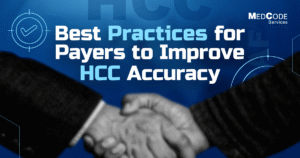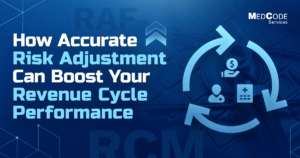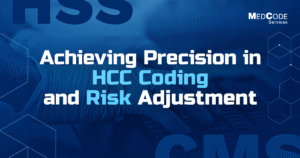Risk adjustment and revenue cycle management (RCM) appear to be separate functions, with one focusing on clinical accuracy and the other on financial workflow; however, in core value, they’re gradually becoming inseparable as healthcare shifts toward value-based care. While risk adjustment ensures that payments accurately reflect patient complexity, RCM oversees the billing, tracking, and collection of payments.
Risk adjustment isn’t just coding; it’s a revenue strategy when paired with strong RCM. As per research, the global RCM market is projected to exceed US$238 billion by 2030, underscoring the growing financial stakes at play. Also, as organizations take on more risk-based contracts, they are being pressured to move beyond retrospective risk reviews and integrate Hierarchical Condition Categories (HCC) coding directly into daily revenue cycle workflows.
Risk Adjustment and How It Impacts the Revenue Cycle
In practical terms, risk adjustment is the process of aligning healthcare payments with the complexity of a patient’s health status. In layman’s terms, it ensures providers treating patients with higher disease complexities are reimbursed fairly. For organizations under value-based care, accurate risk adjustment serves two essential purposes:
- It balances financial risk, and
- It secures the right level of funding for complex populations.
The accuracy of Hierarchical Condition Category (HCC) coding plays an extremely crucial role in this process. Every condition that is documented and coded contributes significantly to a patient’s Risk Adjustment Factor (RAF) score, which points to the expected level of resources that may be required.
An error-free and complete coding record helps ensure that RAF scores reflect the true picture of the complexities of the patient population, thus leading to appropriate reimbursement. On the other hand, coding errors or omissions can lower this RAF score, which in turn reduces payments and leaves providers financially vulnerable.
This is the point where an advanced skill set becomes much needed. Apart from coding, risk adjustment also requires precise documentation, clinical knowledge, and compliance awareness. Coders must rely on well-explained provider notes, while the revenue cycle depends on those codes to drive precise claims and financial outcomes. In a real-world scenario, this alignment works best when
- Documentation is able to support coding without gaps.
- Coding translates clinical complexity into accurate RAF scores.
- Claims reflect both compliance and financial reality.
Our services at MedCode are designed to strengthen exactly these areas. Our team of skilled experts helps providers capture risk more reliably, prevent revenue leakage, and ensure claims are both compliant and financially sound.
Perks of Aligning Risk Adjustment with RCM
- More Accurate Reimbursements
When risk adjustment is integrated into revenue cycle workflows, coding effectively reflects the true complexity of patient populations. This helps in ensuring that reimbursements are well aligned with actual care delivered, preventing underpayments and revenue leakage.
- Minimal Audit Risks
Audits usually happen when there are gaps in coding or mismatched records. The firmer these two are managed, the fewer chances there are for payers to question claims. Error-free documentation paired with effective coding doesn’t just improve payments; it also makes the audit trail clear, cutting down unnecessary back-and-forth with payers.
- Better Care for High-risk Patients
Comprehensive risk capture implies providers have a clearer view of patient health profiles. This allows care teams to design more effective, holistic management plans that help enhance long-term outcomes.
- Financial Planning Ease
Predictable RAF scores and accurate claims lead to steadier revenue flow. This predictability supports better budgeting, resource allocation, and strategic planning for healthcare organizations.
- Fewer Claim Denials
When health records and coding are on point right from the start, claims are less likely to be rejected or delayed. This helps reduce rework, accelerates cash flows, and improves overall revenue cycle efficiency.
Key Challenges Faced in Practice
- Vague Communication Between Coders and Clinicians
Misunderstandings or a lack of communication between providers and coding staff can accelerate risk factors and lead to missed conditions or incorrect HCC capture. This gap often results in under-coding and incomplete risk adjustment.
- Incomplete Documentation
Even the most minute misses in clinical notes can prevent coders from assigning the right HCCs. Without precise and comprehensive documentation, risk scores fail to reflect the true situation of a patient’s health status.
- Delayed Updates
When necessary updates to clinical documents or coding guidelines are not implemented on a prompt basis, organizations risk submitting outdated or inaccurate claims. These delays can mess up the revenue cycles and create compliance risks.
- Staff Burnout
Coders and clinicians are quite often dealing with heavy workloads. The constant demand to balance accuracy, compliance, and speed can cause strain on the staff, elevating the chances of errors in coding and documentation.
- Resistance to Advanced Workflows and Tools
The shift from retrospective reviews to real-time, technology-backed workflows often faces internal resistance. Staff that is comfortable with traditional practices may hesitate to adopt new tools, slowing down efficiency gains.
Steps to Success
- Regular Training for Coders and Providers
Consistent education ensures coders stay aligned with the latest HCC updates, while providers learn to document with a greater sense of the need to detail. This minimizes coding errors and strengthens overall compliance.
- Regular Audit Reviews
Routine internal audits allow teams to detect errors early, validate RAF scores, and correct inaccuracies before they impact claims or set off payer audits.
- Cross-Team Collaboration
Effective coordination between clinical and financial teams is extremely important for ensuring prompt coding and optimizing the revenue cycle. By promoting close collaboration, organizations can strengthen Clinical Documentation Integrity (CDI), minimize claim denials, and ensure that the coded data correctly reflects the patient’s clinical picture.
- Outsourcing for Expert Support
Partnering with specialized firms can bridge skill gaps and bring in-depth knowledge of risk adjustment and coding accuracy.
Why Choose MedCode
At MedCode, we go beyond routine support by offering a structured approach to risk adjustment.
- Technology-Enabled Audits
MedCode conducts risk-adjustment audits, including chart reviews, documentation audits, and medical record assessments, to identify coding gaps and ensure accurate HCC capture.
- Tailored Training Programs
Our coders at MedCode are AAPC and AHIMA certified and regularly participate in robust, continuously updated training programs. These are designed to keep our team at par with the latest developments in models, payer requirements, and documentation standards.
- End-to-End Support Model
We offer comprehensive risk adjustment coding services with full transparency, proactive reporting, and personalized solutions, right from managing documentation workflows to delivering high-quality coding across retrospective, concurrent, HEDIS, and RADV audits.
This integrated model of MedCode helps drive accountability, coding precision, and financial performance.
Conclusion
The interconnectedness between people, processes, and technology is a core element that keeps risk adjustment both precise and sustainable. Building a system with consistent training, credible data, and stronger collaboration between coders and clinicians, organizations can protect compliance, stabilize revenue, and improve patient care.”
Risk adjustment works best when it’s seen not just as a routine task, but as an ongoing practice that adapts and grows with the needs of both payers and providers. For teams looking to add in-depth proficiency without straining their internal resources, partners like MedCode can provide the extra edge, effortlessly helping safeguard compliance, reduce denials, and secure rightful reimbursements.







